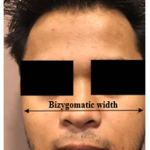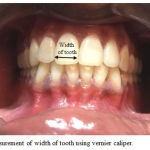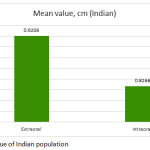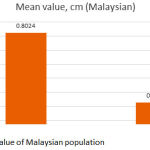Manuscript accepted on :March 21, 2018
Published online on: --
Plagiarism Check: Yes
Mohamad Qulam Zaki Bin Mohamad Rasidi and Ashish R. Jain
Department of Prosthodontics, Saveetha Dental College and Hospitals, Saveetha Institute of Medical and Technical Sciences, Chennai, India.
Corresponding Author E-mail: dr.ashishjain_r@yahoo.com
DOI : https://dx.doi.org/10.13005/bpj/1380
Abstract
There are various anthropometric measurements available to evaluate the reliability of Berry’s biometric index in two different population groups for selection and arrangement of artificial teeth. Berry’s biometric Index (BBI) is one of the method to measure the size of anterior tooth. It is measured by measuring the bi-zygomatic width of patient which is divided by 16. To evaluate and determine the reliability of Berry’s biometric Index in Two Different Population groups, native Indian and native Malaysian. A total of 100 participants, in which 50 Malaysian and the other 50 Indian were participated in this study. The measurements were taken by using a vernier caliper. The measurements were divided into extra oral and intra oral. The extra oral is the bizygomatic width. The intra oral is the width of the maxillary central incisor. By using Berry’s Index formula, the size of the width of central incisor tooth can be determined. For Indian population, the mean values for extraoral width is 0.9202cm. Meanwhile for the intraoral measurement is 0.8266cm. For Malaysians population, the mean values for extraoral width is 0.8024cm. Meanwhile for the intraoral measurement is 0.7526cm. The standard deviation between the measurement of the actual width and the formulated width is only 0.0071 for Malaysian population and 0.0134 for Indian population. The result show a good positive correlation between the upper central incisor and the Berry’s biometric measurement in Malaysian population (r=0.97) compared to Indian population (r=0.83). The selection of maxillary central incisor by Berry’s Index formulae is a useful method as only a slight difference between the actual lengths of the tooth and the formulated one, which is the standard deviation between the measurement of the actual width and the formulated width. Therefore, Berry’s Index formula are proven reliable.
Keywords
Berry’s Biometric Index; Indian; Malaysian Population; Reliability;
Download this article as:| Copy the following to cite this article: Rasidi M. Q. Z. B. M, Jain A. R. Reliability of Berrys Biometric Index in Two Different Population Groups. Biomed Pharmacol J 2018;11(1). |
| Copy the following to cite this URL: Rasidi M. Q. Z. B. M, Jain A. R. Reliability of Berrys Biometric Index in Two Different Population Groups. Biomed Pharmacol J 2018;11(1). Available from: http://biomedpharmajournal.org/?p=19699 |
Introduction
Dental aesthetics have a very important role in our everyday life, especially in mental health as suggested.1 People would not feel much comfortable by showing their teeth appearances to the people surrounding them while they are having any abnormalities or poor in their teeth aesthetics.2 They may have low esteem and feel bad for themselves. Various studies and researches been conducted and proved that the patient having higher self-confidence and improved their body image and appearances when they having excellent dental aesthetics.3,4 It was shown that individuals that are satisfied with their own physical appearance tend to be more successful in social contact.
Dental esthetics has become a famous topic among various dental disciplines. Whenever a treatment is planned for the aesthetic purposes of a patient’s teeth, the clinician should have a logical diagnostic approach which results in the excellent effect.5,6 With few patients, the dentist cannot accomplish the correction alone, however, may require the assistance of other dental disciplines in the field.7
“OHRQoL” is short for ‘oral health-related quality of life’. OHRQoL is a new concept that been emerged several decades ago in dentistry.8 This concept plays an important role in dental practice and research. OHRQoL is a multidimensional construct that includes the subjective evaluation of the patient’s oral health, functional well-being, emotional well-being, expectations and satisfaction with care and sense of health. OHRQoL has a wide range of applications in many studies and research field.9 It is also a part of general health and well-being, even the World Health Organization (WHO) recognized OHRQoL as an important part of the Global Oral Health Program.10 This proves that aesthetics in dental treatment are very important despite the fact that the dental health plays a very important role in our everyday lifestyle and health.11
The need of dental aesthetics is in high demand nowadays. People always define a beautiful smile with a well-arranged, white pearl-like color front teeth accompanied with a perfect red lip.12 This definition along with continuous advertisements from various toothpaste companies had developed the urge among people to have that kind of teeth. The front teeth are the first thing people see when we talk. Therefore, their appearance is very important.
Many writers have commented on the difficulty of choosing suitable replacement teeth for edentulous patients and arranging these teeth so that it will look in a natural view and excellent aesthetic appearance.13 Errors during this treatment stage can always result in patient rejection of otherwise well-constructed, comfortable, and nice dentures. One of the various guides that have been used is named as the “nasal index.”14
The researchers have referred to this guide, which is actually an index that relates the interalar width to the space available for setting the upper anterior teeth and, the width of teeth when selecting a tooth mold. Lee’ had given the estimation that the distance between the outer surfaces of the alar of the nose seemed to be the equal as that between the tips of the canines when each was measured in a straight line, and that the “European nose” varies in width between 28 and 45 mm. Dividers were suggested in order to measure the interalar nose width, but no detailed information was given on how the intercanine distance was measured and what exactly was meant when referring to distances measured in a straight line.15
Few researchers suggested that “parallel lines” extended from the lateral surfaces of the alar of the nose onto the labial surface of the upper occlusal rim could be used to give a position estimation of the midline vertical axis of the upper canine teeth.16 A flexible plastic ruler can be used in order to measure the distance between the “canine lines” on a wax rim of the predetermined curvature.17 This distance was then used for assessing the width of the anterior tooth molds to be used.
Apart from their aesthetic value in prosthetic dentures, maxillary central incisors are highly important for correct speech, lip support, and providing a harmonious incisal guidance.18 One guide to the anteroposterior arrangement of the anterior teeth is the relationship to the incisive papilla, which is a reliable and relatively stable anatomic landmark, “the middle of which has been measured and observed to lie 10 mm posterior to the incisal edges of maxillary central incisors. Researchers pointed out that as a result of maxillary alveolar ridge resorption the papilla moved forward about 1 mm. The relationship between the incisive papilla and the incisive fossa changed slightly so that the fossa lies slightly posterior to the papilla in the edentulous patients’ mouth. In order to recoup for this alteration, they suggested use of the posterior border of the papilla and the positioning of maxillary canines in a coronal plane passing through the posterior border rather than the middle of the papilla.19
In prosthodontics, the selection of anterior teeth is very important as the size, color and form of the anterior teeth are the aspects that need to be considered for the anterior teeth selection, especially for the complete denture patient.20 The wrong selection could lead to ‘awkward’ appearance of the teeth. Many formulae have been formulated for anterior teeth selection and one of them is Berry’s Biometric Index formula. The aim of this study is to find the reliability of Berry’s Biometric Index formula for anterior teeth selection in two different populations groups.
Materials and Methods
A numerable amount of people were randomly selected for the purpose of this study whose age group are between 17 and 70 years. A letter of consent was given to each participants for their acknowledgement of this study since the measurement of the width maxillary central incisor is needed, therefore they have to open their mouth. The measurement of the bizygomatic width (furthest distance between two most prominent points of cheek bone) is needed. This precaution step was taken to avoid any uneasiness of the participants because maybe some of them are not very comfortable with someone measuring their teeth. A total of 100 participants, in which 50 Malaysian and the other 50 Indian were participated in this study.
The measurements of bizygomatic width was taken by using measuring tape, while the maxillary incisor width was taken by using a vernier caliper. The measurements were divided into extra oral and intra oral. The extra oral is the bizygomatic width (Figure 1). The intra oral is the width of the maxillary central incisor (Figure 2). By using Berry’s Index formula, the size of the width of central incisor tooth can be determined:
![]()
The formula of Berrys’ index is given such that the value of width of maxillary central incisor can be finalized after simple calculation is made. The bizygomatic width or known as extraoral value in cm is divided by 16. The division of the extraoral values in cm by 16 are indicated as the Berrys Index formula itself. The overall result later are tabulated in several tables segregated by two main populations, and the mean values for both population are calculated.
 |
Figure 1: Measurement of Bizygomatic width using measuring tape.
|
 |
Figure 2: Measurement of width of tooth using vernier caliper.
|
Sample size of 100 is choose for this study with the expected reliability of the study is, r=0.80 and the test confidence of 80%. The method used to calculate the sample size is non-parametric binomial reliability demonstration test. 100 sample size is ideal for this study as indicated in this method.
After the data collection, the reliability of the result for India population and Malaysia population are calculated by using Cronbach’s alpha reliability test. The actual reliability, r, value is calculated.
Result
A total of 100 participant were participated in this current study in which from the total, 50 are Indian and another 50 are Malaysians. The result of both population can be seen as the mean value and standard deviation.
The mean value of Berry’s Index for both population are divided into extraoral and intraoral for easy identification. For Indian population, the mean values for extraoral width is 0.9202cm. Meanwhile for the intraoral measurement is 0.8266cm. The graph representation of the mean values of Indian population can be seen in graph 1. The standard deviation of the Berry’s Index in Indian population is 0.0134. The lower the value of standard deviation will show better reliability of the index.
For Malaysians population, the mean values for extraoral width is 0.8024cm. Meanwhile for the intraoral measurement is 0.7526cm. The graph representation of the mean values of Indian population can be seen in Graph 2. The standard deviation of the Berry’s Index in Malaysians population is 0.0071.
From the result, the current study show lowest standard deviation in Malaysian population compared to the Indian population. This show that Berry’s Index in Malaysian population have high reliability if compared to Indian Population in this current study.
 |
Graph 1: Mean value of Indian population
|
From the table 2, the correlation between the tooth width using Berry’s Index formula and the actual width of tooth in Indian population, the reliability of Indian population is, r= 0.83
 |
Graph 2: Mean value of Malaysian population
|
From the table 4, the correlation between the tooth width using Berry’s Index formula and the actual width of tooth in Indian population, the reliability of Malaysian population is,, r= 0.97
The result show a good positive correlation between the upper central incisor and the Berry’s biometric measurement in Malaysian population (r=0.97) compared to Indian population (r=0.83).
Discussion
Dental aesthetics give people the perfect smile they ever wanted and many celebrities and person whom having higher economic status have been consulted their prosthodontist to get that.21 The front teeth, as always been described by non-dental students, is very important in facial attractiveness. Therefore, for dentists, it is their job to give the patients what they want.
The anterior teeth selection during denture process especially for complete denture patient is very important as the wrong teeth selection for them will leave an awkward appearance, unaesthetic appearance and unwanted feedback from surrounding people. Many formulae been formulated for the selection of anterior teeth and one of them is the Berry’s Biometric Index formula.22
In order to replace any tooth that was missing, various methods and techniques were used. In 1872, J.W. White was the first person to come up with the concept of “correspondence and harmony”.17 Tooth form and color play a very important role in the concept he proposed. The concept of “correspondence and harmony” state that the proportion of tooth should correspond to the face size.23,24 The tooth color should also correspond to the facial complexion. Sex and age need to be considered together on this two basis. The “Temperamental technic” was the first accepted technique for selecting tooth form.25 This technique was not widely known by prosthodontist until the year 1885 when the temperamental forms of teeth were manufactured as ‘name set’. During 1887, W.R. Hall came up with the concept of “Typical form concept”.26 He gave the first measurements of the typical tooth forms in his research. The classification basis based on his concept was the tooth’s labial surface curvatures, outline form, and neck width. He classified the form in the classification of ovoid, tapering and square.
The other technique is “Berry’s biometric ratio method” which was introduced by Berry in 1906.27 He proposed the technique that the proportions of the upper central incisor tooth had a definite proportional ratio to face proportions. He suggested that the maxillary tooth was one-sixteenth of the face width and one-twentieth the face length.
Another method for tooth selection is Clapp’s “Tabular Dimension Table Method” concept which was proposed by Clapp around 1910.25 This method was based on selecting tooth size from the overall dimension of six anterior teeth and the vertical tooth space present in the patient. Valderrama proposed “Molar Tooth Basis” concept in the year 1913.26 The tooth size was measured on a one-fourth increment of the size of a Bonwill triangle, and it is determined by measuring the edentulous mandible. “Wavrin Instrumental Guide Technique” was projected by William in the year 1920.17 It was a combination of Berry’s Biometric ratio method and William’s typical form teeth. The next method is “Anthropometric Cephalic Index Method,” which was proposed by Sears in the year 1941. The circumference of the head and bi-zygomatic width determines the size of the tooth. The circumference of the head is divided by 13 or by using the bi-zygomatic width divided by 3.3. The tooth length was said to be in proportion to the face. The Justi Company proposed the “Frame Harmony Method” in the year 1949. This method indicates that the general proportions of the skeleton are in harmony with the size of teeth. The tooth size was determined by one-seventeenth of the total dimension of the upper and lower bearing areas.
As described in the data above, the extraoral width and the width of the actual teeth is slightly shorter than what the formulae had given and the standard deviation between the measurement of the actual length and the formulated length is only 0.0071 for Malaysian population and 0.0134 for Indian population. This difference might not make a big difference in the paper, but for the wearer, it might be a big difference.
However, the different in length of the maxillary central incisor by few millimeters might not be a much of trouble for the patient. The selection of participants is not very open. In this study, the participants with crowding is humbly discarded as later the measurements of the teeth would show a big different from the formulated one. Besides, the participants with partially erupted maxillary central incisor is also discarded as for the same reason, if any, but in this study no participants with that condition were discovered.
When selecting denture tooth moulds, Berry’s ‘biometric ratio’ of 1:16 (maxillary central incisor width to bizygomatic width), that was first reported some one hundred years ago and was the basis for the Trubyte Tooth Selector Instrument, still finds its revered position in some texts. But the width of maxillary central incisor teeth has been compared with a host of different anthropological measurements, including cranial circumference and the person’s height.28
In this study the investigators recruited 149 white British dental students (insufficient numbers of non-whites) and recorded the width of maxillary incisor teeth and vertical and horizontal face and soft tissue measurements. They found there was no relationship between maxillary central incisor tooth dimensions and face proportions; the ‘biometric ratio’ was not confirmed. But blindingly obvious, it was reported that men had larger teeth and faces than women, although ‘sex has little influence on tooth-to-face proportions’.20
Conclusion
The selection of anterior teeth for the complete denture prosthesis is very confusing. There is very least data regarding the aesthetics factor that are reliable to be used as an aid for artificial tooth selection. Dental aesthetics have a very important role in our everyday life, especially in mental health as suggested. People would not feel much comfortable by showing their teeth appearances to the people surrounding them while they are having any abnormalities or poor in their teeth aesthetics.
In prosthodontics, the selection of anterior teeth is very important as the size, color and form of the anterior teeth are the aspects that need to be considered for the anterior teeth selection, especially for the complete denture patient. The wrong selection could lead to ‘awkward’ appearance of the teeth.
However, the selection of maxillary central incisor by Berry’s Index formulae might find it useful as only a slight difference between the actual lengths of the tooth and the formulated one, which is the standard deviation between the measurement of the actual width and the formulated width is only 0.0071 for Malaysian population and 0.0134 for Indian population. The result show a good positive correlation between the upper central incisor and the Berry’s biometric measurement in Malaysian population (r=0.97) compared to Indian population (r=0.83). Therefore, Berry’s Index formula are proven reliable.
References
- Paula J. D., Delcides F., Santos N. C., da Silva É. T., Nunes M. F., Leles C. R. Psychosocial Impact of Dental Esthetics on Quality of Life in Adolescents: Association with Malocclusion, Self-Image, and Oral Health–Related Issues. The Angle orthodontist. 2009;79(6):1188-93.
CrossRef - Manipal S., Mohan C. A., Kumar D. L., Cholan P. K., Ahmed A., Adusumilli P. The importance of dental aesthetics among dental students assessment of knowledge. Journal of International Society of Preventive & Community Dentistry. 2014;4(1):48.
CrossRef - MacPherson S. Self‐Esteem and Cosmetic Enhancement. Plastic Surgical Nursing. 2005;25(1):5-20.
CrossRef - Klages U., Zentner A., editors. Dentofacial aesthetics and quality of life. Seminars in orthodontics. 2007. Elsevier.
- Sellen P. N., Jagger D. C., Harrison A. Methods used to select artificial anterior teeth for the edentulous patient a historical overview. International Journal of Prosthodontics. 1999;12(1).
- Gržić R., Špalj S., Lajnert V., Glavičić S., Uhač .I, Kovačević-Pavičić D. Factors influencing a patient’s decision to choose the type of treatment to improve dental esthetics. Vojnosanitetski pregled. 2012;69(11):978-85.
CrossRef - MQZBM R. Health of gingiva in patients post dental implant therapy-A Cross sectional study. Research Journal of Pharmacy and Technology. 2016;9(9):1333-6.
CrossRef - Gherunpong S., Tsakos G., Sheiham A. Developing and evaluating an oral health-related quality of life index for children; the CHILD-OIDP. Community dental health. 2004;21(2):161-9.
- Locker D., Jokovic A., Clarke M. Assessing the responsiveness of measures of oral health‐related quality of life. Community dentistry and oral epidemiology. 2004;32(1):10-8.
CrossRef - Gherunpong S., Sheiham A., Tsakos G. A sociodental approach to assessing children’s oral health needs: integrating an oral health-related quality of life (OHRQoL) measure into oral health service planning. Bulletin of the World Health Organization. 2006;84(1):36-42.
CrossRef - John M. T., Reiβmann D. R., Schierz O., Wassell R. W. Oral Health–Related Quality of Life in Patients with Temporomandibular Disorders. Journal of orofacial pain. 2007;21(1).
- Salim N. B. A., Jain A. R., Varma A. Reliability of H. Pound’s Formula for Anterior Teeth Selection. Biomedical and Pharmacology Journal. 2017;10(2).
- Prasad K. D., Hegde C., Kumar A. Selection and Arrangement of Teeth for Esthetic Complete Denture Prosthesis-An Art And Science.
- Thomson A., Buxton L. D. Man’s Nasal Index in Relation to Certain Climatic Conditions. Journal of the Anthropological Institute of Great Britain and Ireland. 1923:92-122.
CrossRef - Mavroskoufis F., Ritchie G. Nasal width and incisive papilla as guides for the selection and arrangement of maxillary anterior teeth. The Journal of prosthetic dentistry. 1981;45(6):592-7.
CrossRef - Rai R. Correlation of nasal width to inter-canine distance in various arch forms. The Journal of Indian Prosthodontic Society. 2010;10(2):123-7.
CrossRef - Kumar M. V., Ahila S., Devi S. S. The science of anterior teeth selection for a completely edentulous patient a literature review. The Journal of Indian Prosthodontic Society. 2011;11(1):7-13.
CrossRef - Wehner P. J., Hickey J. C., Boucher C. O. Selection of artificial teeth. The Journal of prosthetic dentistry. 1967;18(3):222-32.
CrossRef - Dwivedi A., Yadav N. S., Mishra S. K. Inter-Canthal and Inter Alar Distance as a Predictor of Width of Maxillary Central and Lateral Incisor â An In Vivo Study. Annals of Medical and Health Sciences Research. 2017.
- Kurt A., Isik-Ozkol G. Conventional methods for selecting form, size, and color of maxillary anterior teeth: Review of the literature. European Journal of Prosthodontics. 2015;3(3):57.
CrossRef - Janini M., Jain A. R. Reliability of Sear’s Cepholometric Index in Determination of Width of Maxillary Anterior Teeth in South Indian Population. Biomedical and Pharmacology Journal. 2017;10(4).
- MQZBM R. Review on History of Complete Denture. Research Journal of Pharmacy and Technology. 2016;9(8):1069-72.
CrossRef - Waliszewski M. Restoring dentate appearance: A literature review for modern complete denture esthetics. The Journal of prosthetic dentistry. 2005;93(4):386-94.
CrossRef - Gupta R., Nagpal A., Saini S. S., Katna V. Esthetics In Complete Denture. Indian Journal of Dental Sciences. 2014;6(3).
- Young H. Selecting the anterior tooth mold. The Journal of Prosthetic Dentistry. 1954;4(6):748-60.
CrossRef - Kohli S., Bhatia S. Anterior Teeth Selection in Edentulous Patients–An Esthetic Enigma. Medical Science. 2013;2(9).
- Antony P. J., Pillai K. S., George G. B., Varghese T., Puthalath M. S., Arakkal L. J. Applicability of Berry’s index in bite mark analysis. Journal of forensic dental sciences. 2015;7(1):28.
CrossRef - Scandrett F. R., Kerber P. E., Umrigar Z. R. A clinical evaluation of techniques to determine the combined width of the maxillary anterior teeth and the maxillary central incisor. The Journal of prosthetic dentistry. 1982;48(1):15-22.
CrossRef







